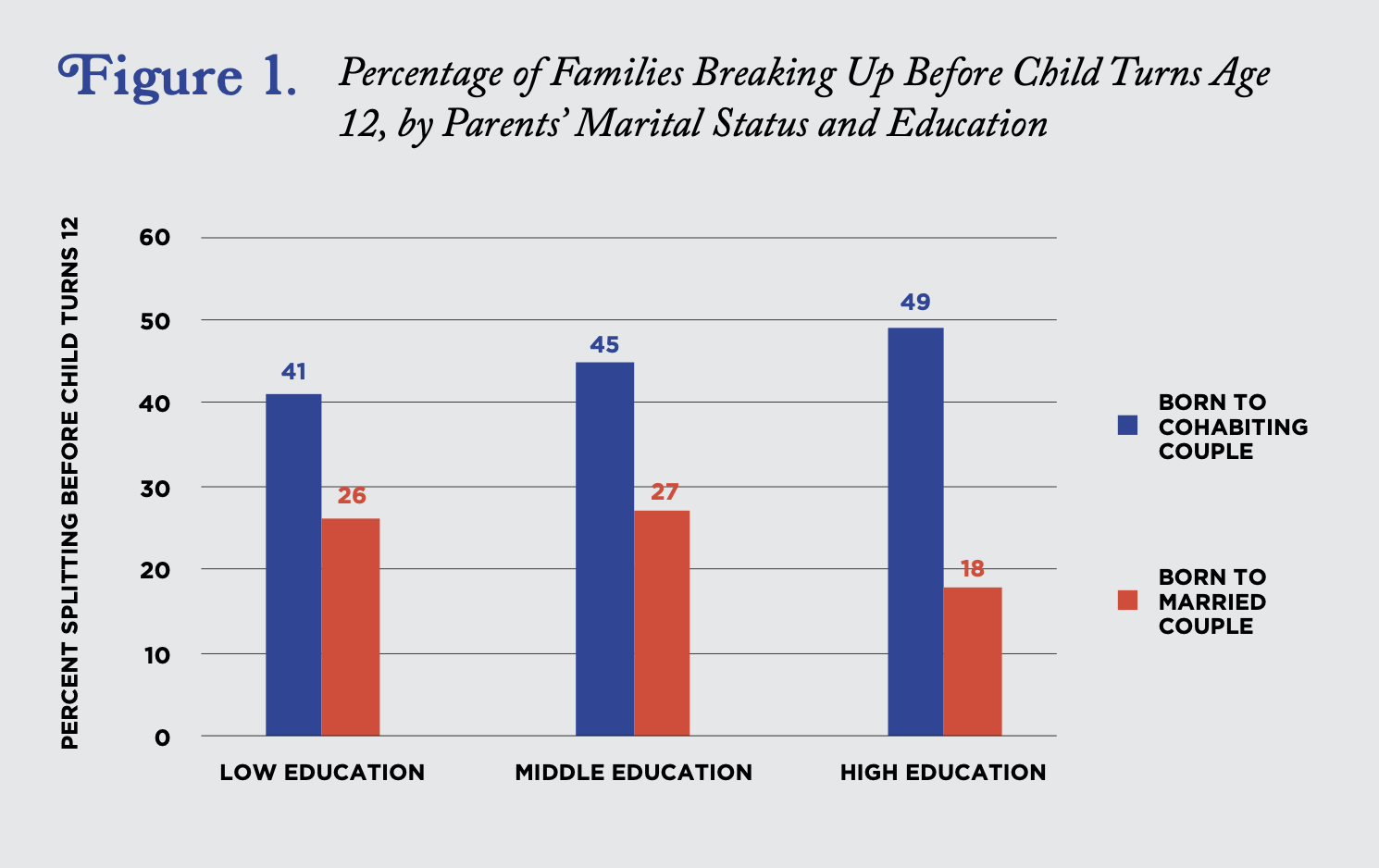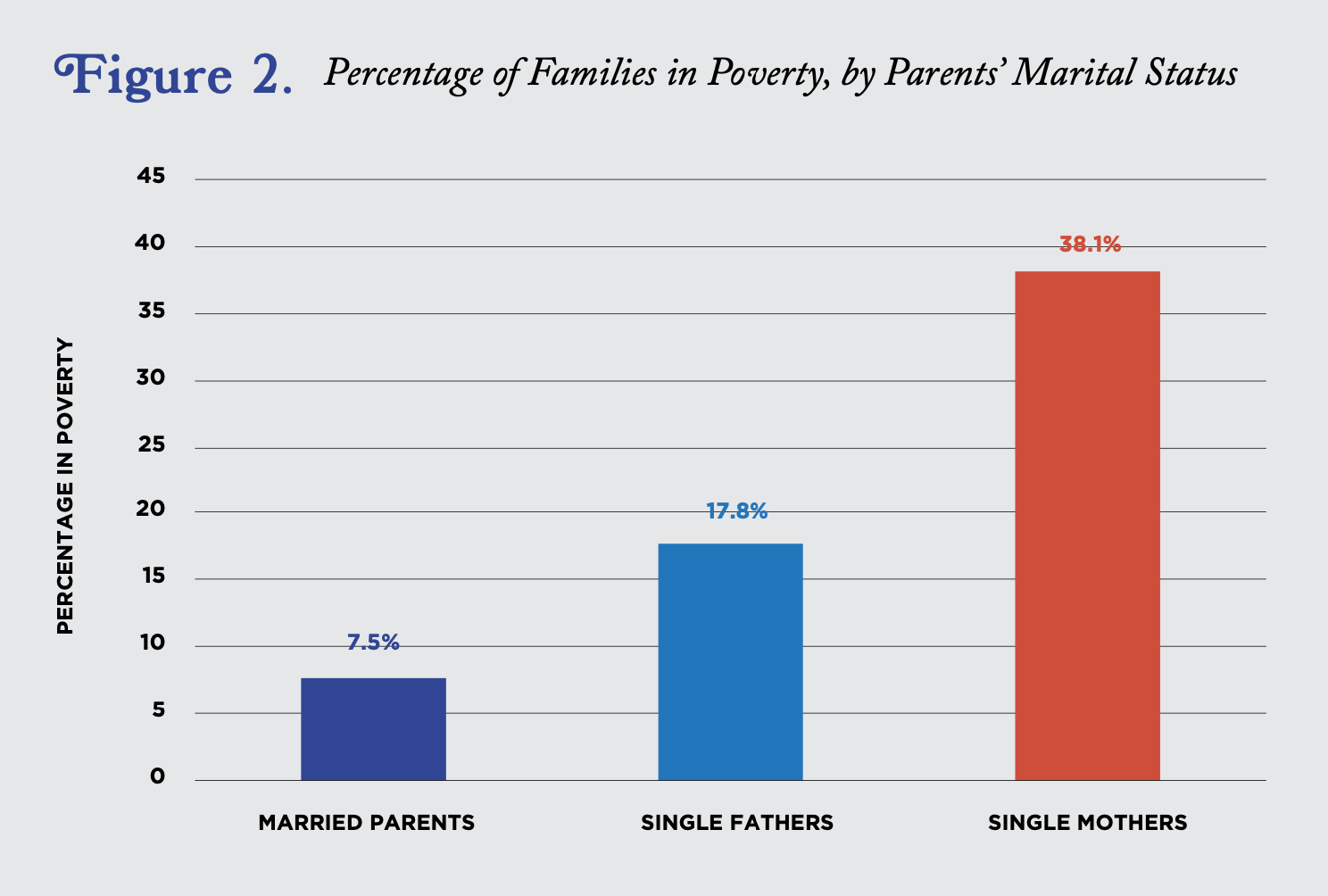3/6 Bridging America’s Social Capital Divide - THE DATA
“The family is the source of life and growth. Families build values, encourage (or discourage) their children in school and out. Families — far more than schools — create or inhibit life opportunities. A huge body of evidence shows the powerful role of families in shaping the lives of their children.”7
– James Heckman, Nobel Laureate
1. GOOD FOR KIDS
There is no institution with greater influence over the social connectedness and social capital formation of children than the family. Families are responsible for the environment in which children are raised. They shape children’s beliefs on what it means to build a happy, flourishing life and have innumerable impacts on their decision making and development as they transition into adulthood. Crucially, an ever-growing body of scientific literature confirms that a married, two-parent household is the family structure most likely to offer children a stable family life, the involvement and affection of their two parents, and access to crucial educational and financial resources. In other words, marriage is the institution that maximizes the odds that a child will thrive.
Accordingly, social science research has concluded for decades that the American Dream is more alive when stable marriages anchor the lives of children—and the communities in which they grow up. No family arrangement besides marriage affords children the same shot at achieving that dream.
Social capital assets. Children raised in stable, married homes are more likely to get the emotional resources—attention, affection, and consistent nurture—they need to thrive in life. They are much more likely to have involved and affectionate parents, and their parents are more likely to keep track of their whereabouts and to shape their behavior in a consistent fashion. Additionally, children raised in stable, married families are much more likely to develop satisfying and engaged relationships with their fathers.
Children born to cohabiting couples, by contrast, are almost twice as likely to see their parents break up, even after controlling for confounding sociodemographic factors such as parental education. Figure 1, which displays the likelihood that children in different living arrangements will see their parents break up by age 12, exemplifies the added stability of married families in America.
SOURCE: Estimates from the National Survey of Family Growth.
Capital assets. Children raised in stable, married families also benefit from having higher and steadier streams of income. Partly because two-parent families are more likely to have two earners, and also because married families are less likely to be plagued by the costs associated with family instability, children in married families enjoy markedly higher family income and lower risks of poverty and material deprivation. Figure 2 indicates that children living in single-parent homes are more than twice
as likely to live in poverty, compared to children in married-parent homes. Indeed, research suggests that child poverty would be markedly lower if the nation enjoyed 1970 levels of marriage.
SOURCE: 2018 Current Population Survey data queried through the Integrated Public Use Microdata System.
Education outcomes. When it comes to education, children in stable, married families are more likely to excel in school, generally earning higher grade point averages. These effects are even stronger for social and behavioral outcomes like school suspensions, high school dropouts, and schools contacting parents about their child’s negative behavior. Children from married homes are also more likely to attend and graduate from college. Research from Melissa Kearney and Philip Levine suggests that the effects of married parenting on high-school completion are largest for children from less educated homes, though the effects for other outcomes, such as college completion, are largest for children from college-educated homes.
Economic mobility. The relationship between family structure and children’s later economic wellbeing is well established. Beyond predicting poverty rates in the short term, the benefits of married family structure extend over a child’s lifetime.
A recent study by Richard Reeves found that the chances of upward economic mobility are different for low-income children of married versus unmarried parents. Four-out- of-five children born into the bottom income quintile who were raised by married parents had risen out of that range by adulthood. In contrast, those raised by a never- married single mother had only a one-in-two chance of doing the same.
This finding suggests the social capital security provided by stable, married families fuels the accumulation of financial capital—rather than these stable, married families being simply a benefit generated by those with money.
Family stability is good for children. As sociologist Andrew Cherlin has noted, “Children who experience a series of transitions [with partners moving in and out of the household] appear to have more difficulties than children raised in stable two-parent families, and perhaps even more than children raised in stable, lone-parent families.”
2. GOOD FOR ADULTS
Being a part of a stable, married-parent family does not just produce the best life outcomes for children; it is also beneficial for adults, especially men.
Financial wellbeing. Economists often refer to a “marriage premium” in earnings and wealth for men who are married versus their unmarried counterparts. Married men tend to earn between 10 and 30 percent more than comparable single men. Further, those men who are able to enjoy a stable married life usually accumulate more assets than their peers who never married or divorced, benefiting from a second income and economies of scale. Research also suggests that stably married men and women tend to have accumulated greater wealth—more than three times greater—by their early pre-retirement years than those who never married and those who had married and then divorced.
Social capital accumulation. Men in committed, stable relationships are also more likely to be oriented toward social-capital-building activities such as participation in extended family, involvement in civic organizations, and membership in a faith community. Married men in stable families also tend to have better mental-health outcomes than do their single counterparts. A little less than half (43 percent) of married men report they are “very happy” with life, in comparison to just one in five single men (20 percent) and cohabiting men (21 percent). The Fragile Families and Child Wellbeing Study showed that stably married fathers were about 25 percent less likely to experience major depressive episodes than were nonresident fathers. Large scale longitudinal studies continue to demonstrate that suicide rates are higher among singles than married men and women, with one analysis suggesting that suicide was 48 percent more common among never-married individuals than those who were married or cohabiting.
Overall, the evidence suggests marriage leads to longer lives as well. The accumulation of stronger income, deeper engagement with work, more resilience, better mental health, and involvement in building social capital networks, may explain findings that conclude men who marry, and remain married, live nearly ten years longer than their unmarried peers.
3. GOOD FOR SOCIETY
Stable families are good for society.
Neighborhoods. There is clear correlation between family stability and positive social outcomes that extend to the neighborhood level. Strong families, for example, are more conducive to effective supervision and consistent nurture, which reduces the likelihood that children—especially young men—will act out and get in trouble with the law. By extension, communities with greater numbers of single-parent homes have markedly higher levels of crime and violence than do communities with a higher concentration of two-parent families. Indeed, Harvard sociologist Robert Sampson has observed that “Family structure is one of the strongest, if not the strongest, predictors of...urban violence across cities in the United States.”
Harvard economist Raj Chetty and his coauthors found a strong community effect in upward mobility that aligned well with family-structure differences across geographic areas. Chetty found that the most predictive factor of upward mobility in a community was the share of homes with two parents present in the household. This factor was more predictive than other measures such as school quality, income inequality, or racial segregation. Chetty’s research also found that the difference in economic mobility between black and white boys is smaller in communities with a greater share of present fathers and married adults.
4. GOOD FOR THE ECONOMY
Stable families are clearly better for the American economy.
More work and higher GDP. Marriage is associated with higher rates of
work and lower rates of labor-force detachment among men. Indeed, the academic literature suggests real evidence to this effect. Higher rates of marriage at the state level are linked to greater GDP per capita and higher median family incomes.
Household assets. Marriage tends to engender savings, more income, and less vulnerability to economic shocks such as job loss, protected as they are by the potential for two sources of income.
Educated workers. Children in stable families tend to perform better in educational attainment, while adults in stable families tend to be healthier, live longer, and be more engaged in the labor market. The supply of educated workers for the American labor market is critical to the country’s ongoing economic success in an expanding global economy with rising national competitors. Additionally, the shift
to an increasingly digital workplace requires new skills, with a premium placed on emotional intelligence in a context of rising automation.
Public Spending. Stable families are associated with less crime, better health, more work, higher incomes, and less addiction. All of the above help to explain the disproportionately low cost of married families when it comes to public services (e.g., policing, courts, emergency medicine) and federal safety-net funds. Households with children enrolled in SNAP in 2018 were twice as likely to be headed by a single parent than by two married parents. The same trend follows for other crucial safety-net programs as well. By contrast, economically and socially prospering families are able
to contribute more to the public purse through taxation. In fact, married Americans account for only 50 percent of adults in the United States, but they contribute nearly three quarters of federal tax revenue. With a lower uptake of federal benefits and higher contribution to the public treasury, stable, married families are an important cornerstone of our country’s economic health.
5. POSITIVE TRENDS
Though many challenges pose serious threats to the family landscape of America, some noteworthy and encouraging family trends have emerged in recent years. For example, as Figure 3 indicates, the divorce rate is down more than 30 percent since the height of the divorce revolution in 1980, and it seems to be headed lower. This means the fabled statistic—that one-in-two marriages end in divorce—is no longer true. A clear majority of marriages today will go the distance. Second, in the wake of the Great Recession, the decades-long increase in nonmarital childbearing has come to a halt and is now falling, albeit modestly.
Less divorce and nonmarital childbearing equals more children being raised in intact, married families. In fact, as Figure 4 shows, since 2014, the share of children raised in an intact, married family has climbed from 61.8 to 62.6 percent. An uptick in children living in intact families has been strongest for black children and children born to disadvantaged mothers, as Figure 5 suggests. The good news about family in America, then, is that a growing share of children overall are being raised in intact, married families.
SOURCE: 1960–1997 estimates based on National Center for Health Statistics data; 2008–2019 estimates based on the American Community Survey.
SOURCE: 2007–2017 estimates based on the American Community Survey; 2018–2019 estimates are projections based on 2018 and 2019 Current Population Survey. Courtesy of Lyman Stone.
Married families are good for children, for adults, for society, and for the economy. Policymakers should consider family stability a central element of any plan to build social capital and to improve socioeconomic outcomes for the country. Yet a number of economic, social, and policy barriers stand in the way of marriage and family life for poor and working-class Americans. In the next section, we identify five problems that policy makers should be concerned with.
SOURCE: American Community Survey data queried through the Integrated Public Use Microdata System.






